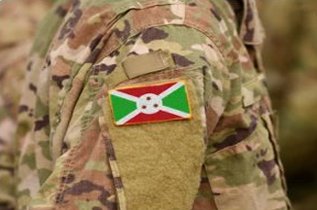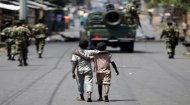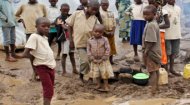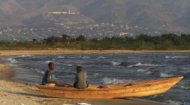|
Peace in Burundi
[Editor: This article requires updating.]
At the outbreak of any war, the consequences can never be predicted and never more so than during a civil war, with neighbour fighting neighbour, brother fighting brother, then, when an uneasy peace descends, putting sustainable communities back together again, with rebel fighters returning to communities on which they preyed to live in harmony. According to the CIA, not only were there 100,000 internally displaced people within Burundi following the civil war there, a further 352,640 Burundi refugees were living in Tanzania, 17,777 refugees were living in the Democratic Republic of Congo, 4400 were in Rwanda, in addition to those who had fled further afield. |
|
|
Peace has been returning to Burundi for the past few years. This video documentary shows the return of refugees together with the laying down of arms by rebel fighters and highlights the challenges the process generates a process helped by the intervention of peace keeping forces from Tanzania and South Africa, who not only ensure supplies of food and other essential supplies, but who mediate disputes and bring once warring faction together to help rebuild their communities. This is all set against a backdrop of high rates of unemployment within an already poor country hit badly by the global economic downturn with 84.5% of the population living in extreme poverty. (Burundi's export economy is based on tea and coffee production, both subject to wildly fluctuating prices on international markets.)
 Over 85% of Burundi's population live in rural communities eking out a living as subsistence farmers growing crops and rearing animals to survive. Those living in these rural areas rarely have electricity nor safe water supplies and facilities such as clinics, schools and other infrastructure are all lacking. At one point there were just 106 doctors for the country's entire population. The country also suffers from rampant corruption and poor governance, reflected in its poor educational system. Few children go to school, particularly those of an age for secondary education where figures are as low as 8% in some areas due to a lack of qualified teachers and adequate supplies. Over 85% of Burundi's population live in rural communities eking out a living as subsistence farmers growing crops and rearing animals to survive. Those living in these rural areas rarely have electricity nor safe water supplies and facilities such as clinics, schools and other infrastructure are all lacking. At one point there were just 106 doctors for the country's entire population. The country also suffers from rampant corruption and poor governance, reflected in its poor educational system. Few children go to school, particularly those of an age for secondary education where figures are as low as 8% in some areas due to a lack of qualified teachers and adequate supplies.
This poverty, lack of confidence in the government, and bleak outlook for the future amongst the Burundi people who are naturally guarded and wary by nature, does not augur well for the future. There have also been recent disturbing signs of a return to strife with grenade attacks, assassinations and a marked rise in armed robberies and car-jackings. As such, the United States has banned its staff from walking the streets or using public transport after dusk given the high rates of crime which is normally accompanied by gun wielding attackers operating in pairs or gangs. Those using cars are required to travel in convoys of at least two vehicles in case of attack on the roads ~ which can be used by anyone as there are no driving tests in Burundi. The peace in Burundi is also threatened by external forces. Burundi troops together with forces from Uganda make up the 9000 strong peacekeeping mission in Somalia, (AMISOM). In retaliation, al Shabaab, a terrorist group operating mainly in southern and central Somalia, has threatened attacks in Burundi. Should such attacks occur or groups such as al Shabaab make inroads into Burundi, that could only serve to further undermine Burundi's already fractured society where dangers remain evident.
|

 Over 85% of Burundi's population live in rural communities eking out a living as subsistence farmers growing crops and rearing animals to survive. Those living in these rural areas rarely have electricity nor safe water supplies and facilities such as clinics, schools and other infrastructure are all lacking. At one point there were just 106 doctors for the country's entire population. The country also suffers from rampant corruption and poor governance, reflected in its poor educational system. Few children go to school, particularly those of an age for secondary education where figures are as low as 8% in some areas due to a lack of qualified teachers and adequate supplies.
Over 85% of Burundi's population live in rural communities eking out a living as subsistence farmers growing crops and rearing animals to survive. Those living in these rural areas rarely have electricity nor safe water supplies and facilities such as clinics, schools and other infrastructure are all lacking. At one point there were just 106 doctors for the country's entire population. The country also suffers from rampant corruption and poor governance, reflected in its poor educational system. Few children go to school, particularly those of an age for secondary education where figures are as low as 8% in some areas due to a lack of qualified teachers and adequate supplies.






